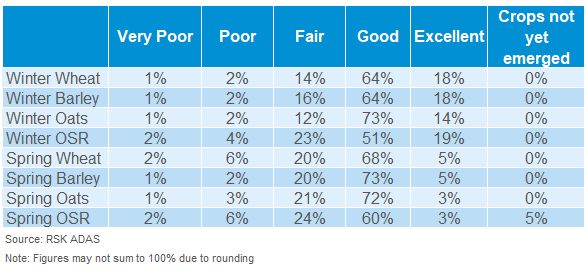Welcome rains in May maintaining UK crop potential: Grain market daily
Friday, 27 May 2022
Market commentary
- UK feed wheat futures (Nov-22) closed yesterday at £322.00/t, gaining £3.50/t on Wednesday’s close. The May-23 closed at £328.15/t, up £3.50/t over the same period.
- Our new crop domestic market followed Paris futures up, while Chicago wheat and maize futures were down on hopes that stuck grain supplies from the Black Sea could start moving again.
- Chicago soyabean futures (Nov-22) closed yesterday at $567.54/t, up 2% on Wednesday’s close. Forecast rains in Northern U.S. plains added to concerns over planting delays, the next update from the USDA will be this coming Monday (30 May).
Welcome rains in May maintaining UK crop potential
The latest AHDB crop condition report, released today, shows welcome May rains have helped maintain the yield potential for winter crops. While most winter crops in our April report were still in good/excellent condition, rain was most definitely need to maximise yield potential and stave off concerns following a dry early spring and declining soil moisture levels. While rain was patchy at the beginning of May, it fell at above average levels from the middle of the month onwards. Not only did this help retain the good yield potential for winter crops; it was essential for spring crops, facilitating nitrogen uptake.
The crop condition report also highlights that, while concerns are still rife given the uncertainty in current and future grain prices, coupled with high input costs, the majority of growers have applied their nitrogen fertilisers as planned. While some were initially driven to cut back on applications, current grain prices have incentivised the majority to maximise yield potential of this season’s crops.
Winter wheat
Winter wheat crops are now pegged at 83% good to excellent, largely unmoved from the end of April (84% good to excellent). However, a greater percentage are now stated as good (64% versus 56% in April) rather than excellent (18% versus 27% in April). The warmth and moisture in May has resulted in rapidly growing crops. Overall weed pressure is low, with patches of blackgrass and Italian ryegrass only being seen above the crop canopies where control was poor.
Mixed reports of BYDV have been received. The presence of aphids is also noted, although at levels below insecticide treatment thresholds.
Winter barley
Winter barley crops are rated 82% good to excellent, against 83% at this condition at the end of April. Weed pressure levels are low, with similar issues occurring as seen in the wheat crop. The same is true for pest pressure.
The prolonged dry period has kept disease pressure low in the crop, although recent rainfall has allowed some late infections of rhynchosporium and net blotch to appear.
Overall, the recent rain has helped retain good yield prospects.
Spring barley
Spring barley crops are rated 77% good to excellent. They are growing well, with the most forward crops to receive a PGR to reduce the brackling risk. Pest pressure remains low, and below threshold levels for insecticide treatment. Crop prospects remain weather dependant and those crops on lighter soils have suffered from the moisture deficit earlier in the spring.
Winter oats
Eighty-six percent (86%) of the crop is now rated good to excellent, up 1 percentage point from April. While some weed pressure has been seen in the crop, the thickening of the crop canopy has increased its competitiveness against weed pressure. The dry spell in early spring has largely kept disease pressure low, although small amounts of mildew and crown rust have been observed. Providing the sunshine and rain continue, crops look well, and yield potential is promising.
Winter oilseed rape (OSR)
The crop condition is about the same as April, with 70% rated good to excellent, versus 71% in April. While cleavers, thistles and wild oats are present in the crop, the thick crop canopy is providing effective competition.
In some of the more backwards crops, insecticides have been applied to occasional crops to control cabbage seed weevils. Cabbage Stem Flea Beetle (CSFB) and pigeons are continuing to put pressure on crops that were already damaged, but this only represents a very small area nationally.
Light leaf spot and sclerotinia remain the main disease pressures, with the latter slightly more prevalent following recent rainfall. However, overall the crop prospects look good currently.
The full crop condition report for 27 May 2022 can be found here.
Sign up for regular updates
You can subscribe to receive Grain Market Daily straight to your inbox. Simply fill in your contact details on our online form and select the information you wish to receive.
While AHDB seeks to ensure that the information contained on this webpage is accurate at the time of publication, no warranty is given in respect of the information and data provided. You are responsible for how you use the information. To the maximum extent permitted by law, AHDB accepts no liability for loss, damage or injury howsoever caused or suffered (including that caused by negligence) directly or indirectly in relation to the information or data provided in this publication.
All intellectual property rights in the information and data on this webpage belong to or are licensed by AHDB. You are authorised to use such information for your internal business purposes only and you must not provide this information to any other third parties, including further publication of the information, or for commercial gain in any way whatsoever without the prior written permission of AHDB for each third party disclosure, publication or commercial arrangement. For more information, please see our Terms of Use and Privacy Notice or contact the Director of Corporate Affairs at info@ahdb.org.uk © Agriculture and Horticulture Development Board. All rights reserved.



